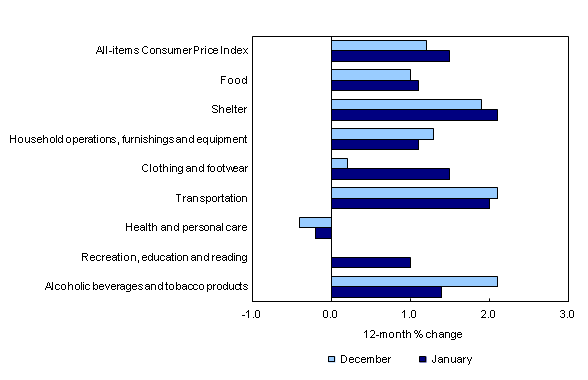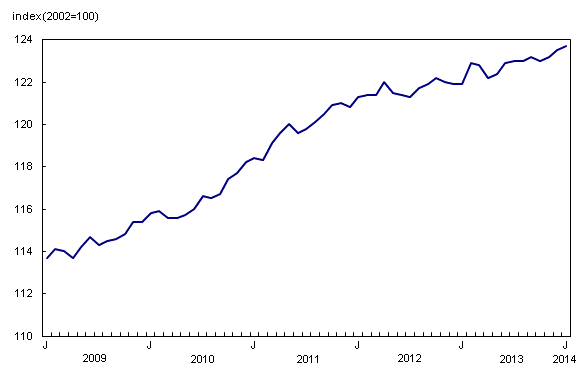Consumer Price Index, January 2014
Archived Content
Information identified as archived is provided for reference, research or recordkeeping purposes. It is not subject to the Government of Canada Web Standards and has not been altered or updated since it was archived. Please "contact us" to request a format other than those available.
Released: 2014-02-21
The Consumer Price Index (CPI) rose 1.5% in the 12 months to January, following a 1.2% increase in December.
Shelter costs lead the rise in the Consumer Price Index
The year-over-year increase in the CPI was led by higher shelter costs, which rose 2.1% in January. This followed a 1.9% gain in December. Electricity prices increased 4.7% in the 12 months to January, after rising 4.1% the previous month. Consumers also paid more for rent (+1.6%) and for homeowners' home and mortgage insurance (+5.4%) in January compared with the same month a year earlier.
The mortgage interest cost index decreased 0.6% on a year-over-year basis in January, the smallest decline since May 2012. On a monthly basis, the index posted its third consecutive increase, rising 0.2%.
12-month change in the major components
Of the eight major components, seven recorded gains in the 12 months to January. In addition to higher shelter costs, price increases for transportation and for food contributed the most to the rise in the CPI. The health and personal care index was the only component to decline on a year-over-year basis in January.
Transportation prices advanced 2.0% in the 12 months to January after rising 2.1% the previous month. Gasoline prices rose 4.6% in January following a 4.7% gain in December. In addition, passenger vehicle insurance premiums were 2.1% higher in January than in the same month a year earlier. Prices for the purchase of passenger vehicles posted a smaller year-over-year increase in January (+0.9%) than in December (+1.4%).
Food prices rose 1.1% in the 12 months to January. Prices for food purchased from stores increased 1.0% on a year-over-year basis after rising 0.8% the previous month. The January increase was led by higher prices for fresh vegetables, fish and seafood as well as meat. In contrast, prices for cereal products and for fruit juices declined on a year-over-year basis in January.
Prices for food purchased from restaurants increased 1.3% in January compared with the same month a year ago. In December, they rose 1.4%.
The clothing and footwear index increased 1.5% in the 12 months to January, after rising 0.2% in December. On a monthly basis, prices for clothing and footwear posted a smaller decrease this January (-0.2%) compared with the same month in 2013 (-1.5%).
12-month change in the provinces
Consumer prices rose at a faster year-over-year rate in six provinces in January compared with December. The largest acceleration was in Alberta, followed by Manitoba. New Brunswick was the only province to post a smaller year-over-year increase in consumer prices in January than in December. British Columbia recorded no year-over-year change in its CPI for the second consecutive month.
Alberta recorded a 2.7% increase in consumer prices on a year-over-year basis in January, following a 2.1% gain in December. Of all the provinces, Alberta recorded the largest increase in gasoline prices (+10.7%) in the 12 months to January. This followed a 4.8% gain in December. Alberta also posted a larger year-over-year increase in natural gas prices (+16.2%) compared with the national average.
Consumer prices in Manitoba advanced 2.6% in the 12 months to January, following a 2.1% gain in December. This acceleration was led by higher gasoline prices, which rose 5.7% on a year-over-year basis in January, following a 0.2% increase in December. Clothing prices in this province increased more than the national average in January.
In New Brunswick, the CPI rose 1.6% on a year-over-year basis in January, following a 1.9% gain in December. This slower increase was largely attributable to a smaller gain in prices for food purchased from stores in the 12 months to January (+0.7%) than in the 12 months to December (+1.8%).
Seasonally adjusted monthly Consumer Price Index increases
On a seasonally adjusted monthly basis, the CPI rose 0.2% in January, matching the increase in December.
On a seasonally adjusted basis, four of the eight major components increased in January, with the largest rise occurring in the recreation, education and reading component (+0.8%).
The seasonally adjusted index for food posted no change in January. However, before seasonal adjustment food prices increased 0.4%, which indicates that the monthly movement in food prices was seasonal.
The only indexes to decline on a seasonally adjusted monthly basis were transportation (-0.4%) and alcoholic beverages and tobacco products (-0.2%).
Bank of Canada's core index
The Bank of Canada's core index rose 1.4% in the 12 months to January, after increasing 1.3% in December.
On a monthly basis, the seasonally adjusted core index rose 0.2%, matching the increase in December.
Note to readers
The travel tours index, which is part of the recreation, education and reading major component, underwent a methodology update effective with the September 2013 Consumer Price Index (CPI). Therefore, until the release of the September 2014 CPI, the 12-month rate of change for this index should be interpreted with caution (because it compares periods before and after the update).
A seasonally adjusted series is one from which seasonal movements have been eliminated. Users employing CPI data for indexation purposes are advised to use the unadjusted indexes. For more information on seasonal adjustment, see Seasonal adjustment and identifying economic trends.
The Bank of Canada's core index excludes eight of the CPI's most volatile components (fruit, fruit preparations and nuts; vegetables and vegetable preparations; mortgage interest cost; natural gas; fuel oil and other fuels; gasoline; inter-city transportation; and tobacco products and smokers' supplies) as well as the effects of changes in indirect taxes on the remaining components.
For a more detailed analysis, consult the publication The Consumer Price Index. The January 2014 issue of The Consumer Price Index, Vol. 93, no. 1 (Catalogue number62-001-X), is now available from the Browse by key resource module of our website under Publications.
More information about the concepts and use of the Consumer Price Index are also available online in Your Guide to the Consumer Price Index (Catalogue number62-557-X), from the Browse by key resource module of our website choose Publications.
The Consumer Price Index for February will be released on March 21.
Contact information
For more information, or to enquire about the concepts, methods or data quality of this release, contact us (toll-free 1-800-263-1136; 514-283-8300; infostats@statcan.gc.ca) or Media Relations (613-951-4636; statcan.mediahotline-ligneinfomedias.statcan@canada.ca).
- Date modified:






